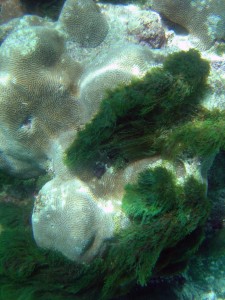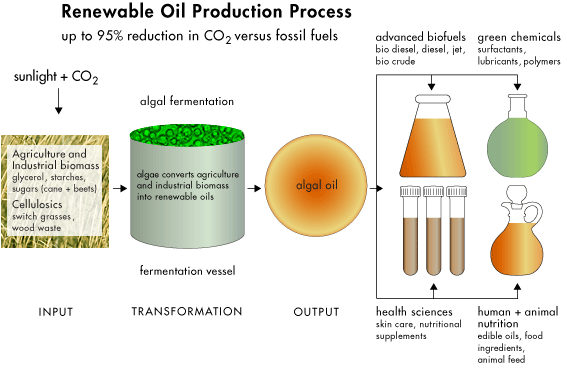
Solazyme’s amazing algaeMar 25, 2010 - marcgunther.com Algae are so good at producing oil from sunlight and carbon dioxide Solazyme, a private company based in South San Francisco, stands out from the algae crowd, for a number of reasons. First, there’s the sheer variety of its products. Solazyme makes fuel for the U.S. Navy. It makes a heart-healthy, vegetarian, protein-rich microalgae power that goes into Garden of Life supplements and vitamins sold at stores like Whole Foods. And it recently announced a deal with Unilever to use algal oil in renewable, sustainable personal care products like soap. Its algae are multi-talented. Then, there’s the fact that Solazyme, unlike other startups, is “producing large volumes of oils and fuels, and we have been for a while,” says its CEO, Jonathan Wolfson. What’s large volumes? An annual rate of tens of thousands of gallons, including a little over 20,000 gallons of shipboard fuel during the first half of this year for the Navy, part of an $8.5 million contract signed last year. Finally, Solazyme raised a Series C financing round of about $57 million during the credit crunch, much of it from existing investors including Braemar Energy Ventures, Lightspeed Venture Partners, the Roda Group and Jerry Fiddler, the firm’s chairman–all of whom stuck by Solazyme through some early stumbles.
I met last week with Wolfson, the company’s 39-year-old co-founder and CEO, whose passion and brainpower are apparent as soon as you meet him. (If you doubt it, come meet him at FORTUNE’s Brainstorm Green conference on business and the environment where he’ll be speaking next month.) Because I’m not a scientist, it’s all but impossible for me to know whether Solazyme’s technology is superior, or whether it will be able to make oil at costs that make economic sense. But others who focus on the industry (like Biofuels Digest, as well as the U.S. Department of Energy) see the company as promising. Algae-based transportation fuels have a lower carbon footprint than diesel or gasoline, and they can be sources in the U.S. Founded in 2003, Solazyme traces its beginnings to Emory University, where Wolfson and Harrison Dillon had just arrived as freshman in the fall of 1989. They met on the first day of school. “What do you want to do?” Wolfson asked, after they’d chatted a little. He figured the answer would be something like “go get a beer” or “check out the town.” “I want to be a geneticist,” Dillon replied. Wolfson, whose father was a medical researcher, was intrigued. During freshman year, the classmates agreed to start a biotech company someday. Let’s be clear,” Wolfson says now. “These were the delusional rantings of 18-year-olds. But ultimately it came to pass.” Wolfson got an MBA and a law degree, worked on an Indian reservation and started a software company before starting Solazyme with Dillon, who by then had earned PhD in genetics and his own law degree. They got off on what they now say was the wrong track, growing algae in ponds, as most algal fuel companies do. A couple of years and a few million dollars later, they told their investors that it wasn’t working. Instead of growing algae in ponds using sunlight as an input, they decided to feed biomass such as sugar cane or switchgrass to their algae and grow them in tanks. This gives the company more control over the production process. Wolfson says:
By genetically modifying the algae, Solazyme can produce a range of products, much as a standard oil refinery can make fuels and chemicals by refining crude oil. The company is exploring three distinct market segments: fuel oils, nutritionals (human and animal nutrition) and health sciences (cosmetics and nutraceuticals). “You have the whole world of chemistry at your fingertrips,” Wolfson says. Can Solazyme do all those different things well? Wolfson says the company’s primary focus remains biofuels. It has a partnership with Chevron, but he can’t say much about that. Other partner like Unilever and a company called B&D Nutritional will help the firm gain entry to other markets. “I’m very excited about food,” Wolfson says. “We can make natural oils. Think about a super heart healthy algo oil with a oil profile similar to olive oil but less saturated fat. We’re not selling it yet, but we’re making it.” The company has even tried making low-fat honey mustard and cookies. Whether Solazyme is biting off more than it can chew (pun intended) remains to be seen. The company has about 80 employees. Its biggest production facility is a plant in rural Riverside, Pa., (owned by a pharmaceutical company) where it is expanding with the help of a $21.8 million DOE grant. Keep in mind that algae’s a risky, crowded business. Sapphire Energy, a prominent competitor, got a $50 million DOE grant and a $54 million loan guarantee from the U.S. Department of Agriculture in January to expand its commercial-scale pond operation in New Mexico. Meanwhile, GreenFuel, another algae startup which raised venture money and signed a commercial production deal, shut down last year. Here’s a diagram illustrating the production process at Solazyme:
|
Email this page to a friend
If you speak another language fluently and you liked this page, make
a contribution by translating
it! For additional translations check out FreeTranslation.com
(Voor vertaling van Engels tot Nederlands)
(For oversettelse fra Engelsk til Norsk)
(Для дополнительных
переводов проверяют
FreeTranslation.com )


 that there are,
that there are, 
